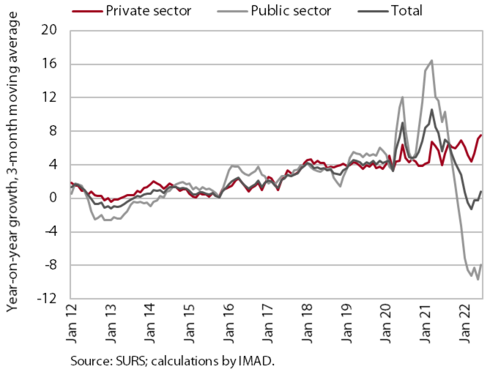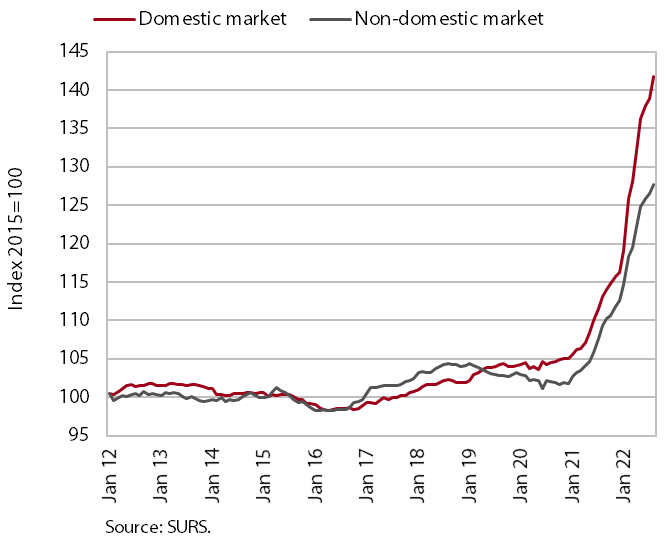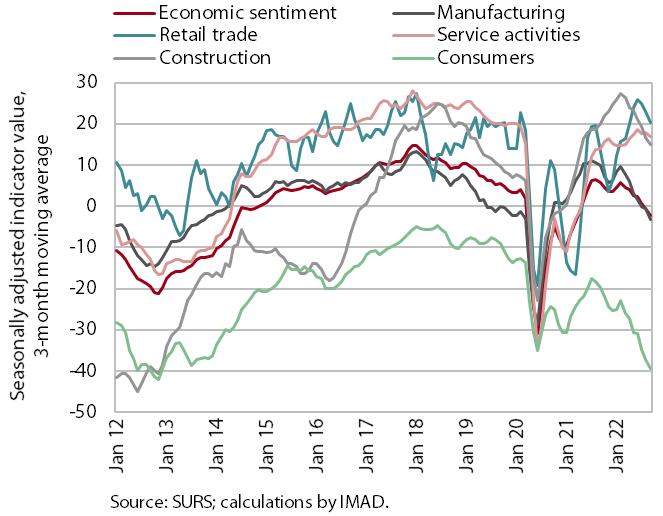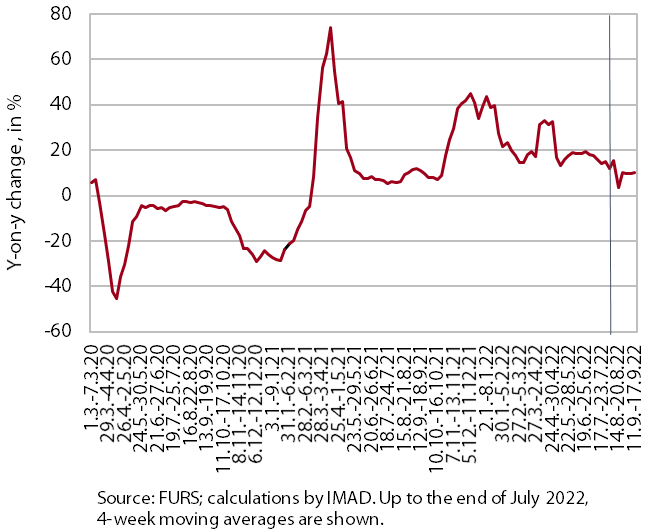Charts of the Week
Current economic trends from 19 to 23 September 2022: average nominal gross wage per employee, Slovenian industrial producer prices, economic sentiment and value of fiscally verified invoices
In the face of high inflation, the average gross wage fell year-on-year again in real terms in July. The decline was more pronounced in the public sector due to last year’s high base, which was related to the payment of COVID-19 bonuses. The year-on-year increase in Slovenian industrial producer prices slowed only slightly in August and remained relatively high. Economic sentiment deteriorated significantly in all segments in September, especially in manufacturing and services, as well as in retail trade. In the first half of September, the year-on-year growth in the value of fiscally verified invoices remained at one of the lowest levels of the past year.
Average nominal gross wage per employee, July 2022

Due to high inflation, the average gross wage fell by 7.1% year-on-year in real terms in July, more in the public sector (11.1%) than in the private sector (4.4%). In the private sector, the year-on-year decline was slightly larger in real terms than in the previous months. In the public sector, the year-on-year growth has also been lower year-on-year in nominal terms since November 2021, which is related to the payment of bonuses during the declared epidemic (which were still being paid in July last year). We expect this decline to slow further in the coming months and to come to a halt towards the end of the year, when an agreement on a public sector wage increase is expected.
Slovenian industrial producer prices, August 2022

The year-on-year growth in Slovenian industrial producer prices slowed slightly again in August. Compared to the two previous months, however, the slowdown in growth was much less pronounced (by 0.1 p.p. to 21.1%). The growth of prices in foreign markets continues to slow down (16.7%), but the growth of prices in the domestic market has increased this time and was again above 25%. Significantly higher energy prices, which more than doubled year-on-year, were the main contributor to the stronger growth in the domestic market, and monthly growth exceeded 10% in August. The rise in consumer goods prices also increased slightly, but the increase was less pronounced than in the first half of the year. Given the slowdown in economic activity, the growth of Slovenian industrial producer prices in the groups of raw materials and capital goods is also gradually weakening, both in the domestic and foreign markets.
Economic sentiment, September 2022

The value of the economic sentiment indicator fell significantly in September and also remained lower year-on-year. After a sharp decline in July and a temporary increase in August, the value of the sentiment indicator decreased by 4.5 p.p. in September and remained below the long-term average. On a month-on-month basis, sentiment deteriorated in all segments, the most in manufacturing (by 7 p.p.), retail trade (by 6 p.p.) and services (by 5 p.p.), and slightly less in construction (by 3 p.p.) and among consumers (by 1 p.p.). Confidence was higher than a year ago in retail trade (by 8 p.p.), while it fell significantly among consumers (by 19 p.p.), in manufacturing (by 16 p.p.) and construction (by 10 p.p.), and slightly in services (by 1 p.p.). Lower consumer confidence is related to the weakening of household purchasing power due to rising prices, while lower confidence in construction is related to rising prices for construction materials and capital goods and increases in interest rates, and in manufacturing to the current conditions in the international environment (supply chain bottlenecks, high raw material and energy prices).
Value of fiscally verified invoices, in nominal terms, 4–17 September 2022

Amid high price growth, the value of fiscally verified invoices between 4 and 17 September 2022 was 10% higher year-on-year in nominal terms and 17% higher than in the same period of 2019. Growth was similar to the previous two weeks, but more moderate than in the weeks before. The largest contribution came from the nominal 10% growth of turnover in trade, where about three-quarters of the total value of fiscally verified invoices is issued. Given the high base of last year (in September last year, the number of overnight stays by tourists was more than a tenth higher than in September 2019), the turnover in the accommodation and food service activities was only 4% higher year-on-year (while it was 22% higher in July and 9% higher in August), with the value of fiscally verified invoices in accommodation establishments being lower year-on-year.
